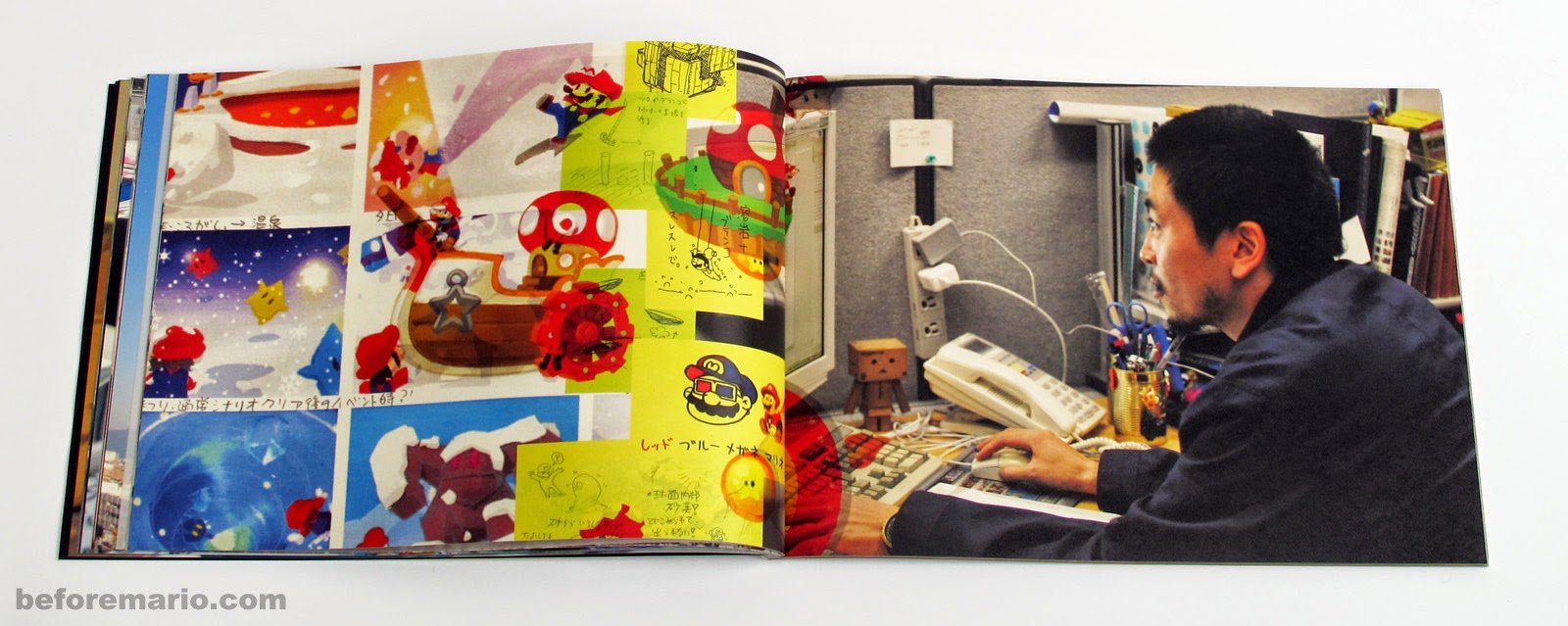These guides are given to prospective employees who participate in the yearly job application process conducted by Nintendo in Japan. The company guide shown here is from 2011.
The front shows a colorful collage of sketches of characters like Mario, Yoshi and Link.
The collages continues on the back, which more familiar faces.
This collage is printed with semi-transparent ink on a plastic sleeve. This sleeve covers the book, which has a white cover.
The white Nintendo logos on the front and back, are actually transparent areas in the sleeve print, that get their color from the cover of the book inside.
 |
| Nintendo company guide 2011 (book and sleeve) |
The book has a simple title, printed in the top right corner of the front cover: "Nintendo Co., Ltd. 2011".
Nintendo Co., Ltd. is the official company name (任天堂株式会社 or Nintendō Kabushiki gaisha in Japanese).
Upon closer inspection, the book cover is not plain white: it contains more sketches, that are printed in varnish-like transparent ink. This is only visible when you hold the book at a particular angle in the light.
The first pages are black, which is a dramatic contrast with the colorful sleeve and white cover.
The book starts with a foreword by Nintendo president Satoru Iwata, in which he introduces the company's goals and philosophy to the employees to-be, under the heading "The Nintendo Difference".
The size of the book is roughly 30 by 21 centimeters. That is A4 landscape, or slighter longer than letter size, for the American readers of this blog.
The book has 96 pages, which is a quite a bit more than the later editions, which had 'just' 64 pages.
Part of the images are printed on opaque sketch paper, which adds some additional interesting visual effects to the book.
The first part of the book shows Nintendo employees at work, mostly at their desk.
This part is the most interesting by far, and luckily also the most extensive, taking up around two-thirds of the entire book.
We see Nintendo staff in all sorts of functions.
Besides the obvious video game designers and developers that you would expect here, there are also people doing administrative, marketing and accounting type work and even two lovely ladies at the reception desk.
Most people are wearing outfits that are common to this type of corporate setting in Japan: business men in white shirts and ties, 'office ladies' in skirts and vests and engineers and developers in more rugged pants and jackets.
As is also common in Japan, these engineer/designer uniforms are provided by the company.
The uniforms are branded with the company logo and a little badge with a picture of Mario and the that internal slogan 'The Nintendo Difference'. Wearing company clothing is an important part of being part of the corporate family.
By the way, in case you didn't recognize him, the gentleman we just saw two pictures up, is none other than Yoshio Sakamoto. Sakamoto-san is one of the veterans at Nintendo, with a resume that is as impressive as it is long. His work includes gems like Metroid and some parts of the WarioWare series, to name a few.
 |
| Yoshio Sakamoto at work on the Metroid franchise |
Throughout the book, many sketches are included of recent Nintendo titles, showing early versions of characters and game scenes.
The actor in the motion-capture studio below is most likely working on a Zelda title.
At least, that is what the attributes in his hands do suggest.
The book's extensive tour of the Nintendo offices provides a rare insight into Nintendo's kitchen.
It shows the many different skills required to bring Nintendo's gaming worlds to life.
You get a good feeling of the, actually quite standard, surroundings in which the creative process happens in the heads and hands of the many designers, engineers and musicians.
One of my favorite parts of the book shows a number of sketches of Cloud Mario (from Super Mario Galaxy 2), printed over a city scape.
The city is Kyoto, as seen from the top floors of Nintendo's headquarters. The Kyoto Tower is clearly visible in the distance as are the mountains surrounding the city.
What I like about these pages, is that they connect the fantasy world (represented by Cloud Mario) with the location in the real world where the magic is created.
 |
| Kyoto, from Nintendo's HQ |
The second part of the book consists of 30 mini interviews with recent hires, who joined Nintendo between two and four years ago.
These bios give a first hand account of what it is like to start working for Nintendo.
The final pages of the book are printed on brown paper.
This section contains basic company information like office locations and organization structure.
The chart on the right shows the company finances over the last twenty years (turnover and profit).
Also included in this section of the book, is an overview of the key events in Nintendo's long history.
Maps indicating the office locations in Kyoto and Tokyo make it easier to know where to show up for the job interview and for your first day at work.
The book's final message is delivered by Nintendo's most famous employee: Shigeru Miyamoto.
It must be a bit daunting but also very exciting to apply for a job where you can call this man your colleague.
If you want to see more of Nintendo's company guides, check out these posts about the following editions:




































No comments:
Post a Comment